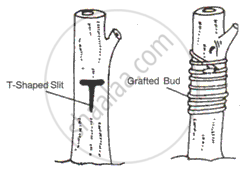Advertisements
Advertisements
प्रश्न
उत्तर
(i) Cutting - In this method, stems are cut into pieces and planted in the soil. This is the easiest and most frequently used method of artificially propagating plants, Eg. - Sugarcane, grapes, rose, etc.
(ii) Layering - Here, an intact branch is bent into the soil and is covered with moist soil. The growing tip remains above the soil. When roots arise in the branch region in contact with soil, it is separated from the parent plant. Within a few weeks, a new plant can be propagated by this method. Eg. - Cherry, jasmine, and grapevine

(iii) Grafting - Here a detached part of one plant called scion is inserted into the stem of a rooted plant called stock. Scion is a short piece of detached shoot containing several buds. Stock is the lower portion of the plant fixed in the soil. The scion is cut and placed face to face with stock. After a few days, a vascular connection is established between the joined parts and parenchyma tissue develops at the junction of the graft. Eg. - Apple, pear, mango, guava.

(iv) Budding - Here a single bud instead of a branch is grafted on the stock. In about two weeks, the bud unites with the stock after which the stock just above the bud is cut off. Eg. - Lemon and hibiscus

APPEARS IN
संबंधित प्रश्न
A student has to focus his compound microscope to observe a prepared slide showing different stages of binary fission in Amoeba. The steps he is likely to follow are listed below in a haphazard manner:
I. Adjust the diaphragm and the mirror of the microscope so that sufficient light may enter to illuminate the slide.
II. Fix the slide on the stage carefully.
III. Adjust the microscope to high power and focus.
IV. Adjust the microscope to low power and focus.
The correct sequence of the above steps to observe the slide under the microscope is
(A) I, II, IV, III
(B) II, I, IV, III
(C) II, IV, I, III
(D) I, IV, II, III
Describe the layering method for the artificial propagation of plants. Illustrate your answer with the help of a labelled diagram. Name any five plants which are propagated by the layering method.
What is a tuber? Name one stem tuber and one root tuber.
With the help of suitable diagram, describe Binary fission in plants.
Find the odd-one out, giving reason.
Cutting, grafting, layering, binary fission.
Differentiate between the following:
Cutting and grafting
Mention the common method of reproduction in Mucor.
A feature of reproduction that is common to Amoeba, Yeast, and Spirogyra is that ______
Offspring formed by asexual method of reproduction have greater similarity among themselves because
- asexual reproduction involves only one parent
- asexual reproduction does not involve gametes
- asexual reproduction occurs before sexual reproduction
- asexual reproduction occurs after sexual reproduction
The symbiotic association between fungi and algae is called ______.
